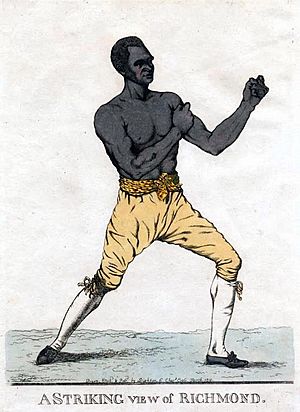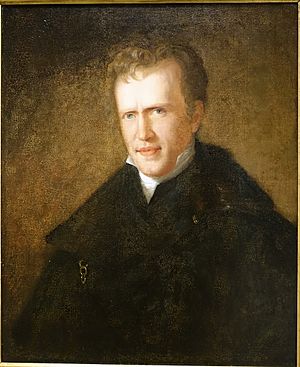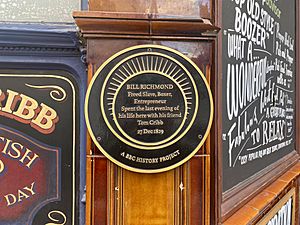Bill Richmond facts for kids
Quick facts for kids Bill Richmond |
|
|---|---|

1810 depiction of Richmond
|
|
| Statistics | |
| Nickname(s) | The Black Terror |
| Rated at | Welterweight |
| Height | 5'9" |
| Nationality | British |
| Born | 5 August 1763 Cuckold's Town, New York, British America |
| Died | 28 December 1829 (aged 66) London, England |
| Boxing record | |
| Total fights | 19 |
| Wins | 17 |
| Wins by KO | N/A |
| Losses | 2 |
| Draws | 0 |
| No contests | 0 |
Bill Richmond (born August 5, 1763 – died December 28, 1829) was a famous British boxer. He was born into slavery in Richmondtown, New York. Even though he was born in Colonial America, he spent most of his life in England. All of his boxing matches happened there.
Richmond moved to England in 1777. There, he received an education that was paid for. He then became an apprentice cabinetmaker in York. In the early 1790s, Richmond married an English woman named Mary Dunwick. They got married in Wakefield on June 29, 1791. Bill and Mary Richmond had several children together.
A boxing writer named Pierce Egan said that Richmond faced unfair treatment in Yorkshire. Richmond was well-dressed, could read and write, and was confident. Egan wrote about fights Richmond had because of insults. One fight happened after someone called Richmond a "black devil" for being with a white woman. This was probably about his wife.
Egan also said that Richmond won five boxing matches in Yorkshire. He beat George "Dockey" Moore, two soldiers, a blacksmith, and Frank Myers. By 1795, Richmond and his family moved to London. He started working for Thomas Pitt, 2nd Baron Camelford. Pitt was a British nobleman and a naval officer. He loved boxing and may have learned from Richmond. Pitt and Richmond often went to boxing matches together.
Contents
Bill Richmond's Early Life and Freedom
Bill Richmond was born into slavery on August 5, 1763. He was enslaved by Rev. Richard Charlton in Richmondtown. This town is on Staten Island, New York. During the American War of Independence, a British commander named Lord Percy saw Richmond. He saw the teenage Richmond in a tavern fight with British soldiers.
Lord Percy then set up more fights for Richmond with other British soldiers. This was for the entertainment of his guests. In 1777, Percy helped Richmond gain his freedom from Charlton. He also arranged for Richmond to travel to northern England. There, Richmond received an education and learned to read and write. He also started an apprenticeship with a cabinet maker in Yorkshire. While working as a cabinet-maker, he met his wife, Mary. Later, they moved to London, where Richmond began his boxing career in his forties.
Richmond's Boxing Career
First Fight Against George Maddox
On January 23, 1804, Pitt and Richmond went to a boxing match. The experienced boxer George Maddox was fighting. After Maddox won, Richmond suddenly challenged him to a fight. Maddox accepted the challenge. When their fight happened, Maddox defeated Richmond in nine rounds.
Pitt died in a duel on March 11, 1804. After this, Richmond left the household. He went back to boxing. He started training and helping other fighters. Soon, he was often at the Fives Court. This was London's main place for pugilistic (boxing) exhibitions. It was on St Martin's Street in Westminster.
Challenging Tom Cribb
By 1805, Richmond had beaten two other boxers, Youssop and Jack Holmes. These wins gave Richmond a chance to challenge the famous boxer Tom Cribb. During their fight, both Cribb and Richmond used a counter-punching style. Observers thought it was a "dull bout." Cribb won the match, and Richmond was very upset. This fight started a rivalry between the two men that lasted for years.
Rematch with George Maddox
In 1808, Richmond returned to boxing. He won several quick fights. This led to a rematch with George Maddox. Their fight happened in August 1809. Richmond showed great skill in "boxing on the retreat." He hit Maddox many times and won the fight. A spectator, William Windham, who was a Member of Parliament, praised both boxers. He said their skill and bravery were as impressive as British troops in the Battle of Talavera that year.
Training Tom Molineaux
Richmond used his winnings to buy a pub called the Horse and Dolphin. It was near Leicester Square in London. At this pub, Richmond likely met Tom Molineaux. Molineaux was another former American slave. Richmond quickly saw that Molineaux had great potential as a boxer. He decided to stop his own boxing career to train Molineaux. Their goal was to challenge Cribb, who was now the national champion. With Richmond as his trainer, Molineaux won two fights easily. Then, he challenged Cribb.
In December 1810, Cribb and Molineaux fought at Copthall Common in East Grinstead, Sussex. It was a very important fight. Many people still talk about it because it was so controversial. Cribb won, but just barely. There was a lot of confusion in the ring. Some people said Cribb was given too much time to recover between rounds. Many believed Molineaux had been cheated.
Historians are not sure if the unfairness to Cribb was because of Molineaux's race. Or if Cribb's supporters were afraid they would lose their bets. Before the fight, some people were worried Molineaux might win. The Chester Chronicle newspaper even wrote that many important boxing fans were "alarmed, lest, to the eternal dishonour of our country, a negro should become the Champion of England!"
In October 1811, Molineaux and Cribb fought again. Cribb won this rematch easily. After the match, Molineaux stopped working with Richmond as his trainer.
Victory Against Tom Shelton
Richmond lost money from betting on the Molineaux-Cribb fight. He had to sell the Horse and Dolphin pub. He needed to earn money again. He became a member of the Pugilistic Society. This was the first group to control boxing in the United Kingdom. In May 1814, when he was 50 years old, Richmond fought Jack Davis and won.
Winning against Davis encouraged Richmond to fight Tom Shelton. Shelton was a respected boxer, about half Richmond's age. Richmond got a bad eye injury early in the fight. But he still beat Shelton after 23 rounds. When the fight ended, Richmond jumped over the ropes with joy. This was a very important moment in his career. Egan said, "Impetuous men must not fight Richmond... The older he grows, the better pugilist he proves himself... He is an extraordinary man."
Richmond's Later Life

Richmond's achievements meant he could have fought for a title. But Cribb was not actively boxing. So, Richmond decided to retire instead. He was known as one of England's top boxers. He showed his skills twice for visiting European royalty. He was also one of the most respected boxing trainers and instructors.
Even more amazingly, Richmond was chosen to be an usher at the coronation of George IV in 1821. He received a thank you letter for this from Lord Gwydyr and Lord Sidmouth.
In the 1820s, Richmond ran a boxing academy. He trained many amateur boxers there. This included writers like William Hazlitt, Lord Byron, and American John Neal.
In his later years, Richmond became good friends with Cribb. The two men often talked late into the night at Cribb's pub. It was called the Union Arms and was on Panton Street in Westminster. Richmond spent his last evening there. He died at age 66 in December 1829. His body was buried near St James's Church, Piccadilly. The burial ground was beside Hampstead Road in Camden, London.
Was Bill Richmond a Hangman?
Some historians have said that Bill Richmond was one of the hangmen who executed Nathan Hale. This happened on September 22, 1776. However, Luke G. Williams wrote a book about Richmond called Richmond Unchained. In his book, Williams says that the Richmond who was the hangman was not Bill Richmond. It was another man with the same last name.
Williams explains that the idea of Richmond being a hangman grew because of several clues. Many stories about Hale's execution mention a Black or mixed-race hangman named Richmond. For example, a book from 1856 called Life of Nathan Hale: The Martyr Spy of the American Revolution mentions "the negro Richmond, the common hangman." Also, a picture of the execution from Harpers Weekly in 1860 shows a Black man holding the hanging rope. Richmond also had a connection to Lord Percy and the British military. And Staten Island was close to where Hale was executed in Manhattan.
Williams says that these clues make it seem possible. But he found other old sources that say Bill Richmond was not involved. He writes that Hale's hangman might have been Black and named Richmond, but it was not Bill Richmond. Instead, newspaper reports say he was a runaway from Pennsylvania. This other Richmond worked as a hangman for William Cunningham. This hangman Richmond ran away from his job in 1781. Cunningham offered a reward for his return. This was four years after Bill Richmond had likely left for England.
Bill Richmond in Pop Culture
The character William Mondrich in the TV show Bridgerton is based on Bill Richmond.


